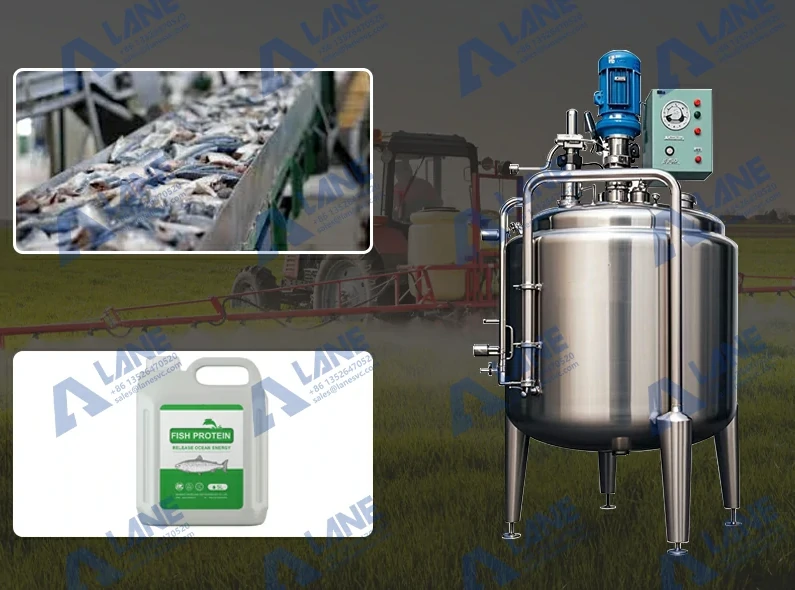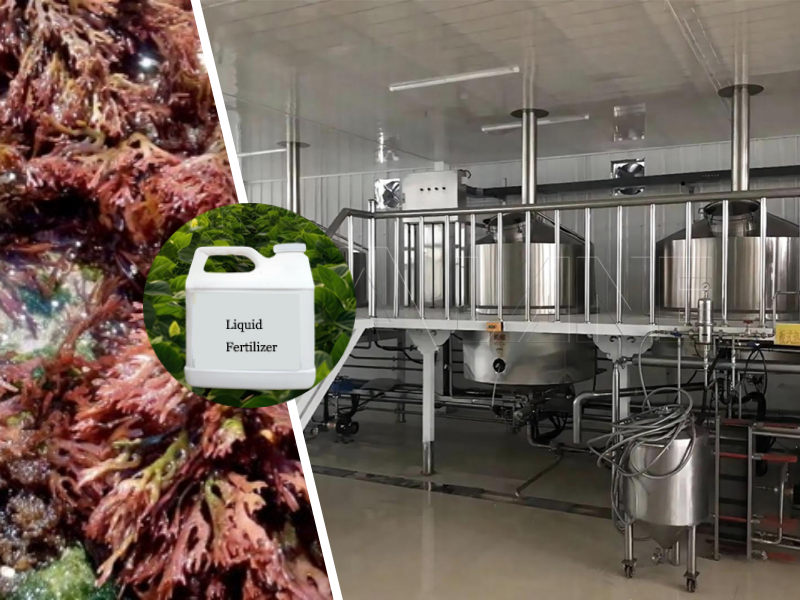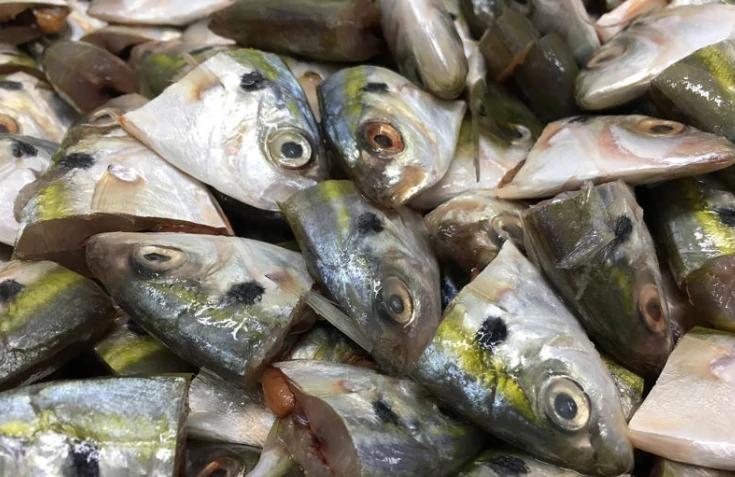
Fish Protein Liquid Fertilizer Production Line: Unlocking Marine Nutrients for Modern Farming
Fish protein liquid fertilizer production line is becoming an essential solution in modern sustainable agriculture. Unlike synthetic fertilizers that often harm soil health and ecosystems, fish protein liquid fertilizer provides crops with a natural and balanced nutrient source derived from marine by-products. The production line ensures these nutrients are processed efficiently, maintaining their bioactive compounds and transforming them into a liquid form that is easy to apply through irrigation systems or foliar spraying.
The global demand for organic and environmentally friendly fertilizers has soared. Among them, fish protein fertilizers stand out due to their high nitrogen content, amino acids and peptide substances, which can directly promote crop growth. By adopting a professional fish protein liquid fertilizer production line, farmers and agricultural enterprises can balance economic benefits and environmental sustainability.

The fish protein liquid fertilizer production line begins with carefully selected raw materials. Typical inputs include:
| Raw Material | Nutrient Contribution | Source Sustainability |
| Fish Waste (heads, bones, offal) | Rich in protein, amino acids, nitrogen | By-product of fisheries |
| Molasses or Sugars | Acts as a fermentation aid and microbial activator | Plant-based, renewable |
| Beneficial Microbial Cultures | Enhance fermentation and bioavailability | Naturally sourced |
| Water | Medium for fermentation and dilution | Universal resource |
These raw materials ensure that the fertilizer contains both macronutrients and bioactive compounds vital for plant growth.

A well-designed fish protein liquid fertilizer production line integrates biotechnology, modern engineering, and strict quality control. The process is not only about breaking down fish residues but also about preserving valuable nutrients while ensuring product safety. Below is an expanded look at the typical production flow:
(1) Raw Material Collection & Pre-Treatment
Fish waste such as heads, bones, viscera, and trimmings is collected from processing plants or fisheries. To maintain freshness, materials are transported under cold-chain conditions. Before entering the production line, impurities like scales or non-organic residues are removed. A crushing machine then reduces the material into a slurry, improving the efficiency of the subsequent enzymatic reaction.
(2) Formulation & Mixing
The ground fish slurry is blended with molasses or sugars to provide an energy source for microbial fermentation. At this stage, beneficial microorganisms or enzyme preparations are introduced. The mixture is homogenized to ensure all particles are evenly distributed, laying the foundation for a stable fermentation process.
(3) Enzymatic Hydrolysis & Controlled Fermentation
Inside a fermentation tank, the slurry undergoes enzymatic hydrolysis where proteins are broken down into smaller peptides and amino acids. Temperature, pH, and oxygen levels are closely monitored by automated systems. This stage is critical because it determines the bioavailability of nutrients in the final fish protein liquid fertilizer.
(4) Sterilization & Heating Treatment
After fermentation, the mixture is gently heated to eliminate harmful pathogens while retaining sensitive bioactive compounds. Advanced heating units within the fish protein liquid fertilizer production line allow precise control, preventing nutrient degradation.
(5) Filtration & Solid-Liquid Separation
The fermented slurry passes through a dual filter or centrifuge, where residual solids such as bone fragments are separated from the liquid fraction. The result is a clear, nutrient-rich solution with consistent quality. The solid by-products can even be repurposed as organic soil amendments, ensuring zero waste from the production line.
(6) Nutrient Enrichment & Homogenization
At this stage, trace elements, humic acids, or seaweed extracts can be added to enhance the fertilizer’s performance. A homogenizer ensures that all components are uniformly dispersed, giving the final product stability and ease of application.
(7) Aging & Stabilization
The liquid is stored in sealed stainless steel storage tanks where it undergoes a natural stabilization phase. This step helps improve the product’s shelf life, flavor (to reduce odor), and microbial balance, making the fertilizer more farmer-friendly.
(8) Final Packaging
The stabilized fish protein fertilizer is transferred to an automatic liquid packing machine, which fills bottles, drums, or IBC tanks with precision. Labels and batch codes are added for traceability, ensuring quality control from start to finish.
By following this carefully structured flow, the fish protein liquid fertilizer production line transforms low-value fish residues into a high-value organic input that supports sustainable agriculture worldwide.

Grain Crops – Enhances tillering in rice and boosts grain filling in maize and wheat.
Horticulture – Improves fruit set and sweetness in tomatoes, peppers, and cucumbers.
Fruit Orchards – Strengthens flowering and prolongs fruit shelf life in apples, citrus, and grapes.
Cash Crops – Increases yield and quality in tea, coffee, and cotton.
Greenhouse Farming – Provides precise nutrient control in high-value vegetables and herbs.
LANE has extensive expertise in delivering turnkey fish protein liquid fertilizer production lines for global clients. Their systems are designed to ensure efficiency, nutrient retention, and scalability. Key advantages include:
Customized Design – LANE tailors equipment capacity and configuration based on client needs, whether for small cooperatives or large industrial plants.
High-Quality Materials – Using stainless steel fermentation tanks and corrosion-resistant pipelines ensures product safety and durability.
Automation Integration – Advanced monitoring systems allow precise control of temperature, pH, and fermentation time.
End-to-End Support – From installation and training to after-sales service, LANE provides comprehensive support to maximize client success.
Sustainability Commitment – LANE aligns production with eco-friendly practices, ensuring compliance with international environmental standards.
As the global push for sustainable agriculture intensifies, the demand for marine-derived fertilizers will only grow. Fish protein liquid fertilizer production lines are expected to integrate more automation, AI-driven monitoring, and energy-saving technologies in the near future.
Furthermore, the combination of fish protein with other organic inputs (such as seaweed extracts or humic acids) will create multi-functional fertilizers, further boosting crop resilience and soil health. LANE, with its focus on innovation, is well-positioned to lead this transformation in the fertilizer industry.
Fish protein liquid fertilizer production line is not just about turning fish waste into fertilizer—it represents the future of sustainable farming. With its nutrient-rich profile, compatibility with modern application systems, and positive impact on soil health, it is becoming a preferred choice for farmers worldwide. LANE’s expertise ensures that agribusinesses adopting this technology gain a competitive edge, delivering both profitability and environmental responsibility.
For more details, please feel free to contact us.
Henan Lane Heavy Industry Machinery Technology Co., Ltd.
Email: sales@lanesvc.com
Contact number: +86 13526470520
Whatsapp: +86 13526470520
Leave a Comment
Latest Posts
LANE has more than 500 successful cases and is committed to providing customers with first-class solutions, high-end machinery and equipment, and one-stop pre-sales, sales and after-sales comprehensive customer service.